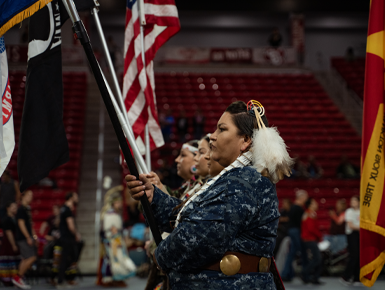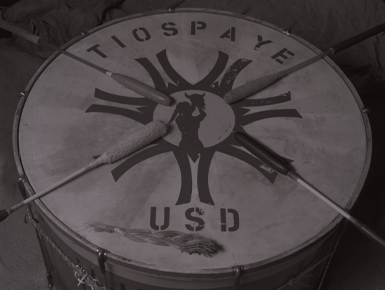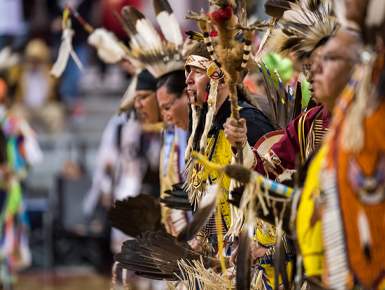The Wacipi's Enduring Spirit: 50 Years of Tradition, Community and Celebration
.png?rev=8da262d7fe474ddfb638b051262d88cb&w=3116020&la=en&hash=5AD7ED3428F3DAA6C2556E284962293E)
The social gathering attracts thousands of attendees from across the state, region and nation, and it has established its prominence as one of the most highly anticipated powwows in South Dakota.
What perhaps makes the Wacipi so special, though, is that it is completely led by students – a fact that has remained true since the first powwow in April of 1972. Additionally, it is the longest-running student-led campus powwow in South Dakota – a reflection of the commitment and tenacity of the students behind the event.
“It’s an incredible accomplishment,” said Cori Bazemore-James ’08, Ph.D., an enrolled member of the Seneca Nation of Indians. “It shows the fortitude of our students to keep the Wacipi going year after year, to continue finding the money and the resources to make it happen, to keep reminding the university of the priority they should have for Native students, communities and traditions.”
“USD produces leaders. The Wacipi being student-led over the years with mentorship by USD faculty, staff and advisors is powerful,” added Tyler Tordsen ’15, an enrolled member of the Sisseton-Wahpeton Sioux Tribe. “Especially when you realize the trust, support and empowerment students are given to pull off an event of this magnitude and the impact it can have on people.”

Over the last 50 years, the Wacipi has evolved and grown, yet at its core, it has clung to the rich tapestry of Native traditions, dance and song. This steadfast legacy is the product of generations of devoted student leaders who have continued to push the powwow forward.
The Heart of the Wacipi
Since 1972, the Wacipi has been led by the Tiospaye Student Council. Originally the Wapaha Club, the student group began in 1957 and has been a system of support for Native students since.
In Lakota, “Tiospaye” encompasses the idea that family and kinship extend beyond immediate blood relatives. This strong sense of extended family and kinship guides Tiospaye students in all that they do.
“When Gene Think Elk was our director, he really emphasized Tiospaye and what the meaning of the word is,” said Selena Stone Arrow ’20, an enrolled member of the Sisseton Wahpeton Oyate. “Our culture is very kinship centered. He made sure that we were practicing that, and it wasn’t just part of our mission, but something that we were actively doing for each other.”
For Collette Bowman ’17, Oglala Lakota and Hunkpapa from Rapid City, South Dakota, Tiospaye not only helped her find community on campus, but it also helped her reconnect with her history and explore her identity.

Bazemore-James added that Tiospaye helped her find family at the university.
“Tiospaye, the word, means extended family, and that literally is what it was for me,” she said. “That was very important for me and helped foster the love I had for the Native community and the USD community as a student.”
Tiospaye organizes several events each year to bring Native students together and celebrate their culture. Of all their events, though, the Wacipi is certainly the most prominent and well-attended cultural celebration.
“The Wacipi shows how significant and important it is to have the Native culture, Lakota and Dakota culture, on campus to help Native students feel seen,” said Stone Arrow. “This is our weekend, our whole Native weekend. I know students who don’t even serve on the committee, they bring their families in because it’s a weekend where we can feel seen and where our culture is appreciated.”
Planning the Wacipi
Putting on an event for thousands of people is no simple task, especially for full-time students who have several other priorities to balance. Planning starts over a year in advance, and students are responsible for nearly every aspect of the powwow – from fundraising and sourcing vendors to finding and inviting drum groups.
Alumnus Wyatt Pickner ’14, Hunkpati Dakota from the Crow Creek Sioux Tribe, served as Tiospaye president for two years, from 2009-2011, and then as a student advisor in the 2011-2012 and 2013-2014 academic years.
“A lot went into planning the Wacipi, like trying to figure out who the head staff was going to be and where the event was going to be held, making sure we had enough funding available to cover the expenses, and paying dancers and drummers,” recalled Pickner.
While planning the Wacipi was a massive endeavor for Pickner and his crew to undertake, in the end, he said it was more than worth it.
“It was definitely a big effort to take on, but then again, it’s part of what we do, bringing people together,” said Pickner. “It was very tiring and exhausting at times, but going into the event and experiencing the energy and being able to see friends and relatives from all over the state come together, it was such an amazing feeling to be a part of that.
“To me, it was one of my favorite times of year – to be there at the Wacipi and just experience it,” he continued. “And it was never just one person doing everything. We all came together to make it happen. Sharing that experience was really great.”
For Tordsen, planning the Wacipi was his first experience fundraising and asking for sponsorships and support from student government, the campus, local businesses and more. “It was overwhelming, but it was exciting,” remembered Tordsen. “It taught me a ton, and I don’t think we would have had the same success if we didn’t have the mentors that we had. Having that guidance was good, and it taught me a lot about event planning, about contracts and about working with a variety of different people.”
Roots that Run Deep
The 50-year history of the Wacipi is not merely a reflection of time but also a testament to the enduring spirit of tradition, culture and community that it embodies.
Bazemore-James finds the evolution of the Wacipi to be an especially remarkable experience, given that the powwow has held a special place in her heart since she was a child. Raised in Vermillion, Bazemore-James grew up dancing in the Wacipi and carried her love for the social gathering with her into her time at USD.

The powwow not only enabled her to connect and celebrate with those around her but also instilled the importance of togetherness and taught her how to treat others.
“I learned a lot through watching my elders who are so involved in the community,” said Bazemore-James. “I learned a lot about how they value people and all the hard work they put into supporting students and hosting guests who are participating in the powwow from all across the country.
“I learned a lot about how to be a community member in our culture,” she continued. “You don’t view yourself as an individual, you view yourself as a community member and you always do things through that lens.”
Stone Arrow shares Bazemore-James’ childhood connectedness to the university’s powwow. Growing up in Yankton, just 30 minutes away from Vermillion, Stone Arrow has attended the Wacipi with her family since she was young.
As a child, Stone Arrow said she felt somewhat disconnected from her roots. “There wasn’t a lot of representation for Native people there; there was nothing really culturally accessible for Native people in Yankton,” she said. Attending USD’s Wacipi opened Stone Arrow’s eyes to her culture in a way she had never experienced before.
“The powwow at USD was one of my rare chances to be around my culture and to see it and be proud of it,” Stone Arrow said. “I know that’s something I’ll always remember – watching the grand entry. When I was growing up, I was always excited to go to the powwow.
“That was my introduction to my culture, and at some points, the powwow was my only access to my culture. That’s what makes it so special to me.”
Beyond the Wacipi
While the Wacipi is undeniably one of the most momentous celebrations of culture and social gatherings at USD, the importance of the spring weekend extends far beyond the two-day powwow.
“The powwow is a great way to celebrate and honor our culture and to have other people experience that with us,” said Pickner. “But we also recognize that powwows are not the only part of our identity – there are other things that are important.”
This realization inspired Tiospaye members to add the Native Alumni Dinner to the Wacipi weekend. Now in its 12th year, the Native Alumni Dinner attracts hundreds of attendees each year and creates space for Native alumni and current students to reminisce and celebrate each other’s accomplishments.
Each Native Alumni Dinner is keynoted by an accomplished USD Native graduate and typically honors select alumni based on a specific theme. The event serves as the official kickoff to the Wacipi weekend and offers alumni the opportunity to socialize and visit campus and Vermillion.
This year’s Native Alumni Dinner will honor the legacy of Tiospaye from the past 50 years.
"We are so excited to welcome back former members of Wahapa Club and Tiospaye Student Council,” said John Little, Ph.D., director of Native recruitment and alumni engagement. “Celebrating the 50th anniversary of the Wacipi would not be possible without the input, dedication and support from the dozens, if not hundreds, of individuals who organized, volunteered at and ran the annual Wacipi through the years.”
Since 1997, the Building Bridges Conference has also been an integral part of powwow weekend. The daylong conference brings hundreds of Native middle and high school students to USD’s campus for keynote speakers, small group sessions and campus tours to introduce them to higher education. Usually held during the day on Friday, the conference’s alignment with the alumni dinner offers a valuable opportunity for building relationships among several generations.
“It allows for students to have an opportunity to connect with Native alumni and current students,” said Pickner. “I think it’s so important to see Native people in higher education institutions and encourage younger students to go to college and show them what it looks like.”
The Wacipi’s Legacy
Sustaining and expanding the student-led powwow and the events surrounding it for over five decades is an extraordinary accomplishment – an accomplishment that can be attributed to the permanent commitment of students, both past and present, to push the event forward each year and cultivate mentorship and kinship.
“That’s part of what we do as Native people – we’re very social,” said Pickner. “We’re very community oriented, so any time we can get together, celebrate, honor each other and be in community with each other is always a great thing.
“I think that’s part of what I was looking for for myself, and I think other students involved in Tiospaye were also looking for,” Pickner continued. “We just wanted to be a part of creating that for ourselves, because that’s what we have always known, and we wanted that environment while we were students.”
Year after year, the Wacipi has continued to grow and flourish. Graduating students provide guidance to those who come after them, passing down the knowledge and connections they gathered throughout their time in Tiospaye.
Bowman – who held roles as both Tiospaye president and student advisor during her undergraduate years – has maintained her commitment as a mentor since she returned to USD as a graduate student in 2020. For her, witnessing the evolution of the student organization she loves so deeply has been a highly rewarding experience.
“Something that I have loved to see is how the student organization grows,” said Bowman. “My gram always taught me to leave things, spaces and people better than you found them because you’re working for the next generation. Seeing this group evolve and change makes me happy; it makes me happy to see that it’s going to outlast me and that they are going to continue to make strides forward.”
Bowman also acknowledges that this evolution would not be possible without the people who came before.
“The fact that it’s been going on for 50 years is very impactful,” said Bowman. “To think about the people who paved a path for me is also really rewarding to see and be a part of.”
Tordsen shares Bowman’s feelings, acknowledging that the powwow’s five decades reflect the tradition of Native culture at the university.
“It speaks to the volume of our university and the rich history and legacy of USD – that they’ve had a culturally significant and exciting event like this going on for 50 years,” he said.
While the Wacipi spans just a single weekend each year, Stone Arrow says the event’s greater role is that it solidifies the Native student community’s presence on campus and showcases all that they are capable of achieving.
“The Wacipi is a time to say, ‘We’re here all year, not just this weekend. We exist, and this is what we can do despite all the challenges we’ve faced and are still facing,’” said Stone Arrow. “The fact that it’s gone on for 50 years is representative of our resilience.”
Historical images courtesy of USD Photograph Collection, USD Archives.
